Megachurches Today 2005
Summary of Research Findings
Scott Thumma, Dave Travis & Warren Bird
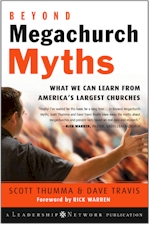
If you are interested in megachurches, you might find this 2007 book co-authored by Hartford Institute professor, Scott Thumma, interesting.
Note: Due to the size of this paper, you may wish to download a copy in .pdf* for easier reading and printing.
*Note: You must have the free Adobe reader
installed on your computer to read this file.
Introduction
At latest count, there are 1,210 Protestant churches in the United States with weekly attendance over 2,000, nearly double the number that existed 5 years ago. This is but one of many significant findings in the Megachurches Today 2005 survey conducted by Hartford Seminary’s Hartford Institute for Religion Research (http://hirr.hartsem.edu) and Leadership Network (www.leadnet.org).
Not a week passes without several stories in the nation’s papers, radio or television in which megachurches figure prominently. Megachurch pastors always dominate lists of most influential religious leaders in the country. As but one example of their influence, during 2005 four megachurch pastors were on the New York Times bestseller lists -- one of the books, with 26 million sales to date, has become the best-selling hardcover non-fiction book in U.S. history, according to Publishers Weekly (and has been translated into 309 languages). Another megachurch pastor has sold 45 million copies of all his books. The third, a first-time author, crossed the 3 million mark in a year and the church he pastors regularly draws 30,000—currently the highest attendance church in the country.
Megachurches are not entirely a new phenomenon. Very large congregations have been around for centuries. In the beginning of the twentieth century there were roughly a half dozen such churches. Sixteen megachurches had attendance over 2,000 by 1960 with the highest being 5,762. Such churches were known locally and in church circles, but they rarely hit national awareness. It wasn’t until the 1970s with the rapid increase of churches this large that they began to capture the attention of the public media.
The visibility and attention of these churches invites both curiosity and misconceptions as to what megachurches are and how they function. The findings from this present study, the most representative survey to date, are offered in the hope of clarifying some of the misunderstandings surrounding these churches.
Physical Characteristics
Size is the primary definitive characteristic of megachurches. In the minds of many persons, size implies success, power and influence. According to the survey results it also denotes considerable resources both monetary and personnel. However, it does not necessarily equate to massive building and giant campuses. Nor does it mean that all these very large congregations function identically due to their very large size. Throughout this report, variation in the size of a megachurch influences its characteristics in ways that went unrecognized prior to this study. Therefore, size is important – not just in setting these churches apart from others but also in understanding variation among them.
The megachurches in our survey reported a 2005 average regular weekly attendance of 3,585 persons. These same churches claimed that 5 years earlier they had an average attendance of 2,279 – an average increase in attendance of 57%. However, not all these large congregations grew at the same rates, in fact, a number of them actually declined in attendance. Comparisons related to the rates of growth contribute interesting insights into possible reasons for that growth. This issue will be discussed more fully in the final section of the report.
The typical U.S. Protestant megachurch is likely to have an attendance in the 2,000 to 3,000 size range. There are increasingly fewer congregations in each category as size increases. Although most people think megachurches have many thousand attendees, in fact only 16% have 5,000 or more in attendance each week.

Just because a congregation attains several thousand in worship does not mean it has a large sanctuary. In the earlier Megachurches Today study undertaken in 1999-2000 and released in 2001, a majority of churches felt they had insufficient building space for many areas of their ministries. This holds true for the current study as well. The median (midpoint of the range – meaning 50% were below and 50% above this figure) seating capacity of the largest worship service was 1,400. Only 5% of megachurches have sanctuaries of 3,000 seats or more. Consequently, 53% of churches hold four or more services over two or three days.
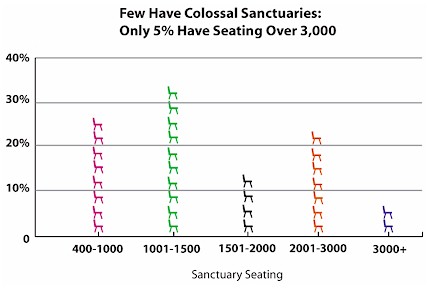
Likewise, these churches have found other ways of creating enough seating for those who want to attend. At least 50% of churches use multiple venues for worship as well as satellite locations to increase seating capacity. Twenty-seven percent hold services at satellite locations (up 5% from the earlier study) and another 27% are considering doing this. Twenty-two percent of congregations claimed to have started a satellite or off-site campus since 2000. Of this group with multi-site locations, three quarters have just one or two additional locations, but 10% have more than 5 separate locations. Additionally, 34% employ a multiple venue worship service format where these services with distinctive styles and focus are held simultaneously in buildings on their main campus. Finally, over a third of churches (37%) stated that they helped plant at least one new congregation in the past 5 years.
| |
Northeast
|
South
|
Northcentral
|
West
|
| 2000 |
6%
|
40%
|
21%
|
33%
|
| 2005 |
6%
|
49%
|
20%
|
25%
|
The present study further confirms the pattern of where megachurches tend to cluster. The four states with the greatest concentrations of megachurches are California (14%), Texas (13%), Florida (7%) and Georgia (6%). Compared to 5 years ago, a larger number of other states now have significant numbers of megachurches in them. The phenomenon seems to be spreading outside the Sunbelt states but not such that it has shifted the distribution across the four regional divisions dramatically in the past 5 years.
A closer look at the nine census divisions however shows considerable diversity around the country. The South Atlantic region of the country now has the highest concentration of megachurches, whereas in 2000 it was the Pacific region. The study also identified that 1% of megachurches can be found in Canada.
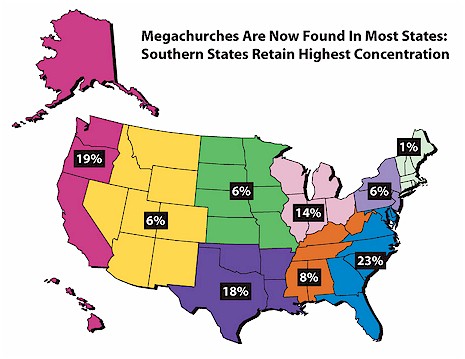
Within these regions, megachurches are concentrated around the largest cities, and within those cities most megachurches are located in the newer suburbs (45%) or the older suburbs (29%). A comparison with the 1999-2000 data seems to indicate an attraction to the newest suburbs either by newly established churches or those moving from older suburbs, and not a flight by megachurches from the downtown and older established inner city areas.
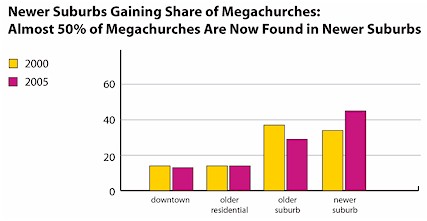
The shifts in the location of megachurches may not just be due to relocation into new suburban areas, it may also be that new congregations are being planted there and then growing into very large churches, very quickly. Whereas in the 1999-2000 study, 57% of megachurches were founded before 1961, the 2005 study shows only 44% in that group. At the same time, 15% of megachurches have been founded in the past 15 years.
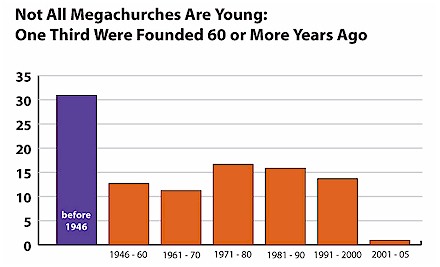
In terms of denominational affiliation between 35% and 40% of megachurches claim to be nondenominational. This is an imprecise figure given that churches in quasi-denominational organizations such as the Calvary Chapel Association, The Fellowship of Vineyard Churches or the Independent Churches of Christ often are uncertain whether to identify as denominational or nondenominational. The groups with the largest numbers of megachurches in our survey sample included nondenominational (36%), Southern Baptist (20%), United Methodist (9%), and Assemblies of God (5%). See Appendix A for a more inclusive listing of all US megachurches by denomination.
While it is clear that many of the megachurches downplay their denominational affiliation (the 1999-2000 survey showed only a third said it expressed its denominational heritage very or quite well), very few changed affiliation (3% in the last 5 years) or became independent (3% since 2000) according to the current study. It is more likely that these churches, at least for 20% of them in the past and 9% in the last 5 years, will change their name, often dropping the denominational label. Likewise, roughly the same percent have begun their own quasi-denominational network of like-minded churches in the past (22% in total but 13% of these since 2000).
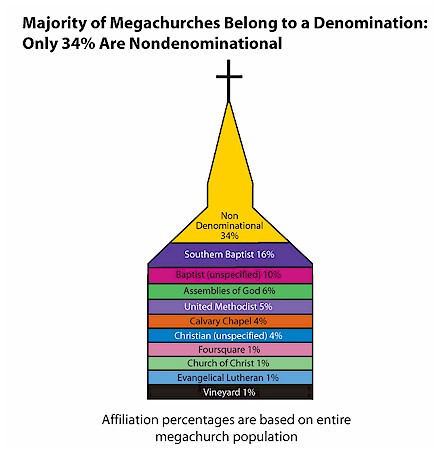
Worship and Identity Characteristics
Members of congregations of all sizes tell researchers that worship is the central function of what their church does when it gathers. Obviously, the total attendance of their worship services is what sets megachurches apart, however, it is often the distinctive characteristics of that worship service that contribute to the church’s growth to mega-size.
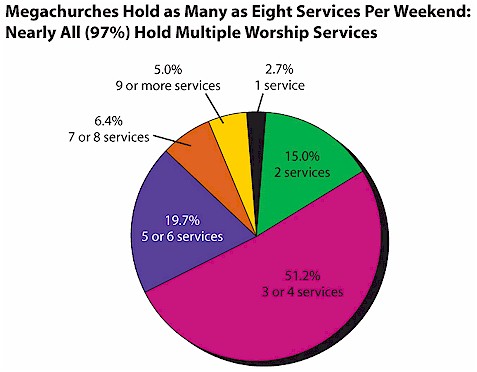
Nearly all (97%) megachurches hold multiple worship services, with 5% holding 9 or more each weekend.
Almost 50% of churches say these multiple services are somewhat or very different in style from their main worship service.
When asked to describe the characteristics of their largest worship service, over 50% of respondents said the traits of being “Filled with a sense of God’s presence”, “Inspirational” and “Joyful” described their worship services very well.

Without a doubt most of the megachurches have incorporated culturally relevant forms into their services. Whether this is a result of growth or a cause of that growth is unknown, nevertheless the use of these contemporary worship forms is very apparent. Roughly 80% use electric guitar or bass and drums “always” in their services, over 93% do so “often” or “always.” Likewise nearly every megachurch uses visual projection equipment all the time. The Faith Communities Today 2000 national study showed a strong correlation between the use of electric instruments and increased growth. This fact is confirmed in this study with the megachurches with the highest rate of growth are also the most likely to consistently use these forms of worship (see details below).
Worship styles at these very large churches are continually evolving. Only 15% of churches say their format or style at any weekend service hasn’t changed in the past 5 years. At the same time, almost 60% said one or more services has changed “some or a lot.” This is a distinct change from our survey 5 years ago when only 42% reported a lot or some change in services. When one examines the willingness to change in those congregations that are growing most quickly, they are the churches reporting to be most likely to attempt and embrace change (see details below).
An aspect of a church’s identity is shaped in worship but it is also broader than that and is inclusive of the church’s culture and connection with the outside world. The identity of these megachurches was measured not only by worship style but also by theological identification, political orientation and the stated cultural characteristics of the congregations. However, aspects of identity can also be seen in the programmatic and spiritual practices the churches thought to be central to their functioning.
When asked to describe the theological identity of the congregation, the majority of churches chose Evangelical (56%). This was followed by 16% who claimed Pentecostal (8%) or Charismatic (8%). Seven percent chose “moderate” and that many also chose “seeker.” “Other” designations (7%) traditional (5%) and Fundamentalist (2%) accounted for the rest. Compared to the study of 5 years ago, this new data indicated considerably more churches choosing an evangelical label, while fewer claim the Pentecostal, charismatic and moderate theological designation.
The perceived political outlook of the majority of megachurch members is much as the popular media portray it. Over 50% were predominantly conservative, with another 33% somewhat conservative. Only 11% chose “middle of the road,” 4% “somewhat liberal” and 2% selected “liberal.” However, such conservatism of megachurches is often touted in articles claiming them to be powerful political players. The data from this study does not support that perception of megachurches as highly political. Only 16% of churches claimed they partnered with other churches in political involvement activities in the past 5 years and three quarters of churches (76%) say they have never done this.
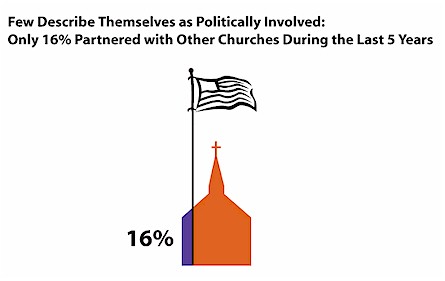
When asked to characterize their congregational identity, 70% strongly agreed that their church had a clear mission and purpose, another 65% strongly agreed the church was spiritually vital and alive, and over 50% strongly agreed that the church welcomed innovation and change and was willing to change to meet new challenges.
| |
% Somewhat or Strongly Agreeing This Trait Describes Their Church |
| Holds strong beliefs and values |
96%
|
| Is spiritually vital and alive |
95%
|
| Has a clear mission and purpose |
91%
|
| Is willing to change to meet new challenges |
90%
|
| Welcomes innovation and change |
86%
|
| Is like a close-knit family |
72%
|
| Is working for social justice |
49%
|
Our 1999-2000 research found megachurches likely to have a significant multi-racial presence in the congregation. This survey confirmed that fact as well, but also offered evidence of a powerful attitude of racial integration at work.
Fifty-six percent of those surveyed said they were making efforts to become intentionally multi-ethnic. These efforts seemed to be effective since on average 19% of persons in the congregations were of the non-majority racial group. Thirty-six percent of churches reported having a 20% or more minority presence and 10% of congregations claimed to have no majority racial group.

Practices and Programs Reflecting Congregational Identity
Much gets said about the alleged weak convictions of megachurch members and the so-called “watered-down” theology of very large churches. There are several indicators in this survey that seem to indicate otherwise. When asked if the phrase “holds strong beliefs and values” described the congregation 78% strongly agreed that it did. Additionally, when questioned how much the congregation emphasizes home and personal practices in worship and education events many of the following characteristics show considerable support among the megachurches.
| |
% Saying Congregation Emphasizes This Trait Quite a Bit or A Lot |
| Personal scripture study |
88%
|
| Personal prayer, meditation or devotions |
86%
|
| Tithing or sacrificial giving |
78%
|
| Family devotions |
53%
|
| Keeping the Sabbath or other worship day holy |
40%
|
Megachurches are well known for offering a wide variety of activities and ministry programs. Our previous study asked the types of programs the megachurches are engaged in and at what rates. This survey, however, asked which of these programs were “key activities” for the congregation. As would be expected religious activities were most highly rated as key activities. Activities such as study and discussion groups (79%), religious education (71%), and prayer and faith sharing groups (66%) scored the highest percentages as key functions within megachurches. Contrary to popular ideas about megachurches being solely concerned with fundraising, this activity garnered the lowest score on the list.
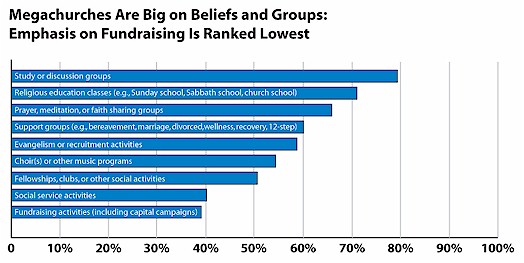
Another claim that is often made against megachurches is that they neglect the needs of their surrounding communities in favor of helping their own membership. While this study did not address this question as extensively as the 1999-2000 study, two questions in the survey challenge that criticism somewhat. Nearly half of megachurch say they partnered with other churches in the past 5 years on a local community service project (54%) or on an international missions project (46%).
Member Characteristics
This survey did not ask many questions about the characteristics of the members of megachurches. The profile that emerges from the few questions asked, however, is that these members are quite likely to be under 60 years old and are often under 35 years old. They are apt to be college graduates and are generally married and have young children. A good many of them are new to the congregation in the previous 5 years and large numbers live within the immediate vicinity of the church. Quite a few participate in small groups and some, although less than many megachurches claim, are new converts to the faith. As previously noted, the membership is often multi-racial and conservative both in terms of political and religious orientation. The survey respondents estimated that on average 21% of the church’s members volunteer weekly for service in the community. See appendix B for more details about the characteristics of megachurch members.

Leadership Characteristics
There is no doubt that the senior pastor is a key component in the success of a megachurch. It would be an exaggeration to conclude from this statement that megachurches are personality cults, or are so tied to one person that they will collapse when that person is gone. Nevertheless, the leader is critical.
For 83% of churches in this survey the dramatic growth of the church occurred during the tenure of this current pastor. The median year this person became senior pastor was 1992, with 33% beginning their ministry at the church prior to 1989 with 35% beginning their tenure since 1995.
The average age of the senior pastors in this study is 50 years while the average age was 52 in the study from 5 years ago. Eighty-nine percent are Caucasian, 8% are African American and 1% Hispanic, 1% Asian and 1% Multiracial in terms of their racial and ethnic background. These pastors are generally well educated with 92% having a college degree or higher; 35% had obtained a doctoral degree.
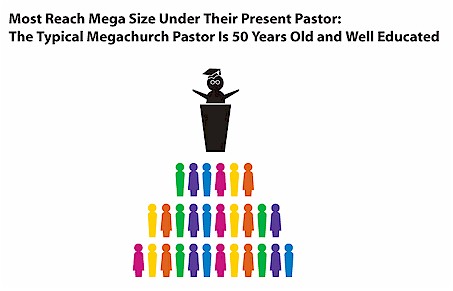
The senior minister is not a lone leader of the megachurch. As a megachurch grows it requires an increasingly complex division of labor and departmentalization. Large numbers of staff and volunteers are needed not just to coordinate and facilitate weekend services for thousands but also to care for the spiritual development of these members and empower them in ministry. The megachurches in the study average 20 full-time paid leadership staff positions and 9 part-time positions. These churches also have on average 22 paid full-time and 15 paid part-time administrative or support staff positions. The average number of volunteers giving 5 or more hours a week to the church workers is 284. Sixty-three percent of congregations claim to have volunteers that spend between 20 and 40 hours a week in service to the church. On average, in these churches there are 35 persons (median of 10 persons) who volunteer at this level. Taking into account all these workers, megachurches on average function at a ratio of 10 attenders to one staff or volunteer.
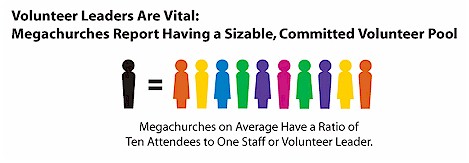
The rapid growth, strong leadership and complex coordination required to generate megachurch success seldom comes without personal disagreement and organizational conflict. When asked whether the congregation experienced disagreements or conflicts in the past two years, 40% of respondents reported some minor conflict and an additional 8% reported major conflict. It is unknown from the survey what the cause or results of these conflicts were, but it is apparent that these churches are not immune to strife. It is interesting, however, that those with the highest rates of growth also have the lowest levels of conflict (see details below).
In terms of financial health, the megachurches in this study appear on the surface to be better off than 5 years ago. The average income received from all sources for the last fiscal year was approximately 6 million dollars. This is a significant increase compared to the 1999-2000 study results, even adjusting for inflation. The average expenditures for the congregations also increased to 5.6 million dollars. This reflects almost the exact same ratio between income and expenses as the 1999-2000 data. It is worth noting that given this average income for the approximately 1,200 megachurches in the U.S. would mean that the combined income from all these congregations is roughly 7.2 billion dollars a year.
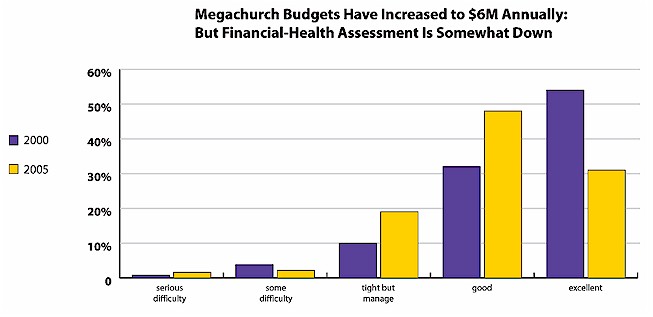
Nevertheless, when the churches were asked to describe their financial situation, considerably less described it as excellent when compared to the 1999-2000 study. Almost 50% described their financial situation as good but almost 20% said it was “tight but they manage.”
Evangelism and Growth
The bottom line for the numerical success of megachurches is that they attract and retain more persons over time than do other churches. This might be due to marketing savvy or seeker sensitive profiles of a target demographic, but it also might mean that these churches are able to excite their members to tell others about their church, to invite their friends and neighbors at a greater rate than other churches.
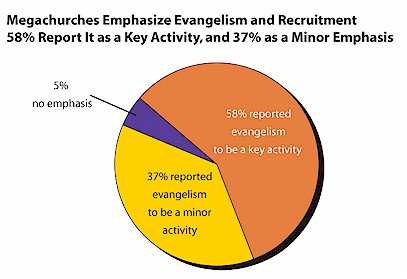
A large portion of the survey explored the megachurch’s efforts to and tactics for evangelization. The results show some interesting patterns, especially when the fastest growing of these churches are compared to the more slowly growing ones.
All but 5% of megachurches claimed to have some emphasis on evangelism and recruitment activities with 58% reporting it to be a key activity and 37% saying a minor emphasis. Clearly megachurches undertake multiple efforts to reach out to nonmembers or make the congregation better known in the community. When asked if they had undertaken specific evangelistic activities in the past year, large majorities of the megachurches claimed to have engaged in all these efforts.
| |
Percent Doing This Activity In The Last 12 Months |
| Established or maintained a web site for the congregation |
96%
|
| Encouraged members to invite others to worship services |
94%
|
| Encouraged members to tell nonmembers about their faith |
93%
|
| Sponsored a program or event to attract visitors |
84%
|
| Mailed or distributed newsletters, letters, or flyers |
77%
|
| Advertised on radio or TV or in a newspaper |
75%
|
| Developed a plan to recruit new members |
60%
|
| Contacted people who recently moved into the area |
41%
|
The encouragement of members to engage in evangelistic activities is not an insignificant tactic. Several research studies indicate that congregations grow by word of mouth, as participants invite their friends. The members of these megachurches follow the encouragement of their church leadership and are involved in recruitment of new members. Forty-seven percent of churches say their members do this a lot and 37% say members engage in recruitment to some extent, 14% say members are a little involved, and only 3% say their member are not at all involved in this activity.
There is a difference between bringing new people to a service and connecting with them so they come back and make a commitment to the church. Following up with visitors is critical in an organization with such open boundaries for persons to wander in off the street. Over three quarters (77%) of churches contact visitors by mail, almost the same percentage (70%) contact first-timers by phone as well. Slightly smaller percentages of churches use email (38%) or personal visits (29%) to follow up with visitors. Leaders of these congregations claim to make on average 145 visits or phone calls (median = 64) each month to prospective members, worship visitors, or newcomers to the community. Only 7% of megachurches say they rarely, if ever, contact their visitors.
Once a person shows interest in a megachurch, the leadership often engages in numerous intentional efforts to help the newcomer become integrated into the congregation. The 1999-2000 megachurch study identified that 96% of churches strongly encourage new members to volunteer in the congregation’s ministries, 76% require an informational class, and 32% assign a “mentor” to help incorporate new persons into the church. The present study found similar efforts to integrate persons into the life of the church.
| |
% Doing This Activity
|
| Invitation to participate in a fellowship or other small group |
88%
|
| An orientation class for new members |
78%
|
| Invitation to volunteer for service in the congregation or the community |
69%
|
| Designated people extend hospitality and invite them for meals |
58%
|
| Follow-up visits by clergy, lay leaders, or members |
52%
|
| Other activities |
22%
|
| No planned procedures or activities |
3%
|
A Look at Patterns in Megachurches by Date of Founding
The numbers of Protestant churches with average attendance over 2,000 has continued to increase dramatically over the past decades. This research project has identified over 1,200 megachurches, which increases the previously known number of churches by almost 400. That means it is possible that nearly a quarter of all megachurches have been founded in the past 15 or 20 years. When a church is relatively young, it tends to function in ways that set it apart from an older congregation. In particular, being founded recently has a discernable effect on the functioning, identity and member composition of the congregations. The more recently a megachurch was founded the more rapidly it is likely to be growing.
| Founding date |
Average % of growth in 5 years |
| Before 1946 |
47%
|
| 1946-1970 |
55%
|
| 1971-1990 |
83%
|
| 1991-2005 |
424%
|
Likewise, the more recently a megachurch was founded, the greater median 2005 attendance it has.
| Founding date |
Median 2005 Attendance
|
| Before 1946 |
2,600
|
| 1946-1970 |
2,859
|
| 1971-1990 |
3,000
|
| 1991-2005 |
3,440
|
Megachurches founded since 1991 are more likely to be nondenominational and less likely to describe their congregation as traditional, moderate, Pentecostal or charismatic, but they are more likely to say they are seeker oriented.
The more recently a megachurch church was founded the greater the likelihood the pastor is younger and has less formal education.
The membership on average of these more recently founded churches is significantly younger. This membership also has more families with children, a slightly larger multiracial percentage, more new converts and more people who are new to the congregation in the last 5 years.
In terms of the worship style and atmosphere, these more recently founded churches are less likely to use choirs and piano but much more likely to have electric guitars and drums in the service. The services are also described as informal and exciting at higher rates than churches founded in earlier periods. This optimism perhaps aroused an evangelistic fervor in members since the churches founded most recently were more highly rated as having members involved in recruitment.
Finally, the megachurches founded since 1970 scored significantly higher on saying they welcome innovation and change and have a clear mission and purpose than do churches founded earlier.
A Look at Patterns in Megachurches by Size Groupings
Not all megachurches are the same size. Variations in size make more differences than just the amount of income, staff and other resources. In comparison with more recently founded megachurches, the larger the megachurch the more likely it is to be seen as having an exciting worship service. These largest churches are also significantly more likely to use electric guitars and drums, while also less likely to use a piano frequently in worship.
These churches are described as being more spiritual vital and alive, welcoming of innovation and change, having a clear sense of mission and vision, holding strong beliefs and values and being willing to meet new challenges when compared to megachurches of smaller sizes.
The membership of these largest churches has larger percentages of younger people and smaller numbers of those over 65 years old. They claim to have much larger percentages of persons who are new converts. They are somewhat more likely to be nondenominational.
|
Church Size
|
Average Income
|
FT ministerial &
admin staff
|
Volunteers
5hr+
|
Median 5yr
growth rate
|
|
1,800 – 1,999
|
3.17 million
|
21
|
126
|
38%
|
|
2,000 – 4,999
|
5.20 million
|
36
|
236
|
44%
|
|
5,000 – 9,999
|
9.14 million
|
64
|
533
|
56%
|
|
10,000 or more
|
24.80 million
|
131
|
904
|
74%
|
A Look at Patterns in Megachurches by Rates of Growth
The growth rates of most megachurches are such that most churches only dream about, but even among these congregations the rates vary considerably. The rate of growth among megachurches alters more than just their size.
The largest worship service of the fastest growing churches is described as having higher scores of being informal, filled with a sense of God’s presence, joyful, exciting, inspirational and thought-provoking than other megachurches. The faster growing a church is the more it is described as being more spiritual vital and alive, having a clear mission and vision, holding strong beliefs and values, meeting new challenges and welcoming innovation and change.
Likewise, those with higher rates of growth over the past 5 years also have more persons under 35, fewer persons over 65, a larger percentage of families with children and not surprisingly, more new converts and persons new to the congregations in the past 5 years. These congregations also have larger percentages of members reported to be involved in recruitment as well as increased scores on the question of whether the church has people assigned to extend hospitality to new members.
A somewhat surprising finding was that almost none of the many evangelistic programs and efforts (such as advertising, creating recruitment plans, sponsoring visitor events, contacting persons new to a community or actually contacting persons after they visited the church) we tested had a strong influence on the variable growth rates of these megachurches. If anything the increased rates of growth seem to be more due to the characteristics of worship and the active involvement of the membership in recruitment.
| |
Grouping by Growth Rates
|
|
No growth or decline
|
1 to 20% growth
|
21 to 50% growth
|
51 to 100% growth
|
More than 100% growth
|
|
What extent members involved in recruiting new members
|
Not at all
|
6.5%
|
1.8%
|
3.3%
|
2.4%
|
1.2%
|

|
A little
|
32.3%
|
21.8%
|
9.9%
|
14.3%
|
7.1%
|

|
Some
|
41.9%
|
40.0%
|
42.9%
|
33.3%
|
27.1%
|

|
A lot
|
19.4%
|
36.4%
|
44.0%
|
50.0%
|
64.7%
|
Interestingly, as the education levels of the pastors decrease, the rates of growth of these churches increase. This finding is similar to the findings from the Faith Community Today 2000 study. It raises interesting questions about the mentoring of young pastors and the role of seminaries in producing clergy to fill these very large congregations.
The rate of growth of these megachurches is also strongly correlated with the reported absence of conflict in the congregation. Those churches that grew by the greatest percentage also experienced the least amount of major conflict and conversely those that experienced on growth or an actual decline in attendance had the greatest rates of major conflict.
| |
Grouping by Growth Rates
|
|
No growth or decline
|
1 to 20% growth
|
21 to 50% growth
|
51 to 100% growth
|
More than 100% growth
|
|
Has the church had conflicts or disagreements in past 2 years
|
No conflict I am aware of |
9.1%
|
50.0%
|
50.0%
|
56.1%
|
66.7%
|

|
Some minor conflict |
60.6%
|
38.9%
|
43.3%
|
40.2%
|
33.3%
|

|
Major conflict |
30.3%
|
11.1%
|
6.7%
|
3.7%
|
.0%
|
All these findings leave more unanswered questions than they offer conclusive answers about what makes these very large congregations so successful. The research team will continue to analyze the information over the coming months to further explore the insights within the survey.
Eleven Misconceptions Explored **
As the introduction to this report noted, one goal of the Megachurches Today 2005 research is challenge stereotypes that may be inaccurate or inappropriate. The Megachurches Today 2005 survey instrument is based on descriptive questions and statements (see below for more details on the survey itself). However, the research findings readily lend themselves to challenging various false impressions as to what megachurches are like and how they function. The following material explores 11 of those misconceptions.
MYTH #1: All megachurches are alike.
FACT: They differ in growth rates, size and the things they emphasize.
MYTH #2: All megachurches are equally good at being big.
FACT: Some megachurches clearly understand how to function as a large institution but others flounder noticeably at being big -- and some even struggle and decline.
MYTH #3: There is an over-emphasis of money in all the megachurches.
FACT: Our data doesn’t show this. Rather it is often a low priority, except when engaged in a building or capital campaign. At the same time, most don’t shy away from occasional sermons about putting God first in individual financial priorities and preaching on tithing.
MYTH #4: Megachurches are just spectator worship and are not serious about Christianity.
FACT: Our data shows that most megachurches demand a lot; they have high spiritual expectations and serious orthodox beliefs and preaching.
MYTH #5: These large churches only care about themselves and are not seriously involved in outreach and social ministry.
FACT: Considerable ministry is going on at the megachurches from solitary outreach to the local communities, joining with other churches in an area to tackle problems, as well as contributing to efforts nationally (say in New Orleans) and internationally (such as ministry to persons with AIDS in Africa)
MYTH #6: All megachurches are major political players and pawns or powerbrokers to the Republican Party or George Bush.
FACT: A vast majority of megachurches surveyed said they are not politically active. This parallels survey data on smaller churches, most churches have an internalized separation of church and state. A few megachurches and their pastors are vocally politically active but not most, not even a majority.
MYTH #7: All megachurches have huge sanctuaries and enormous campuses.
FACT: Megachurches show widespread use of multiple worship services over several days, multiple venues, and even multiple campuses. Mega refers to attendance, not building size.
MYTH #8: All megachurches are nondenominational.
FACT: While many megachurches are nondenominational and most others often act like it, the vast majority belongs to some denomination.
MYTH #9: All megachurches are homogeneous congregations with little diversity.
FACT: A large and growing number of megachurches are multi-ethnic and are intentionally so. Likewise, many of them have considerable diversity in terms of class, education levels, income, ages, backgrounds, occupations, and even theological and political styles.
MYTH #10: Megachurches grow primarily because of great programming.
FACT: Megachurches grow because excited attendees tell their friends. They may be encouraged and helped to do so by church leadership but it is not what megachurches “do” in terms of evangelistic programs, neighborhood surveys, etc. that makes them grow. The survey did not show any significant correlations between the programmatic items and the increased rates of growth in the fastest growing ones.
MYTH #11: The megachurch phenomenon is over and on the decline because it was just a Baby Boomer phenomenon. Gen Xers and Millennials aren’t interested in megachurches.
FACT: The increased numbers of megachurches we found is shocking, and it seems there are many more on the way. We see no indication of this trend slowing. Others have pointed out that the biggest churches in all denominations are getting bigger over time, since the 70s. Likewise, the idea that youth don’t find megachurches appealing could not be further from the truth. While the megachurch phenomenon exploded with the Baby Boom, it was around before them and will be after them. Many of the fastest growing, largest and newest megachurches are full of people under 35 years old. Not all youth like megachurches, but then neither do all Baby Boomers.
** These and other myths will be explored in greater detail in Scott Thumma’s upcoming book on megachurches.
Conclusions: What Does All This Mean?
These findings of the Megachurches Today 2005 project clearly indicate that not all megachurches are alike. It is a mistake to assume that all these very large churches are monolithic and function in a similar fashion. While they do have many characteristics in common (often they have more in common with each other than they do with smaller churches), they are not all identical. The above information points to several variables such as founding data and size that affect the functioning and dynamics of the megachurches. It is likely that after additional analysis other variables such as denominational affiliation, region, and dominant race of the congregation will also be shown to have an effect on their functioning.
Second, while there is some overlap among the groupings of most recent, fastest growing and largest churches, the patterns in the data discussed above are consistent across founding periods, all growth rates and different sizes of megachurches. Therefore, the characteristics that repeated in this analysis such as adaptation to change, sense of being spiritually vital, having a clear mission as well as youthfulness of the congregation and the use of electric guitars and drums, and the rates at which members tell others about the church are significant variables in terms of growth and health of the churches.
Third, these findings indicate that much more research of a nuanced and careful nature should be done if we are to accurately understand the dynamics of these largest and influential congregations.
There are many misconceptions about megachurches, inaccuracies that this research and the activities of the sponsoring organizations hope to dispel. As explained in appendix C, our two organizations have teamed up to do this research project because we are eager to provide correct and accurate information about megachurches in the United States. Churches large and small have much to gain from a comprehensive national picture of large churches throughout the country.
If you have questions, please direct them to:
|
